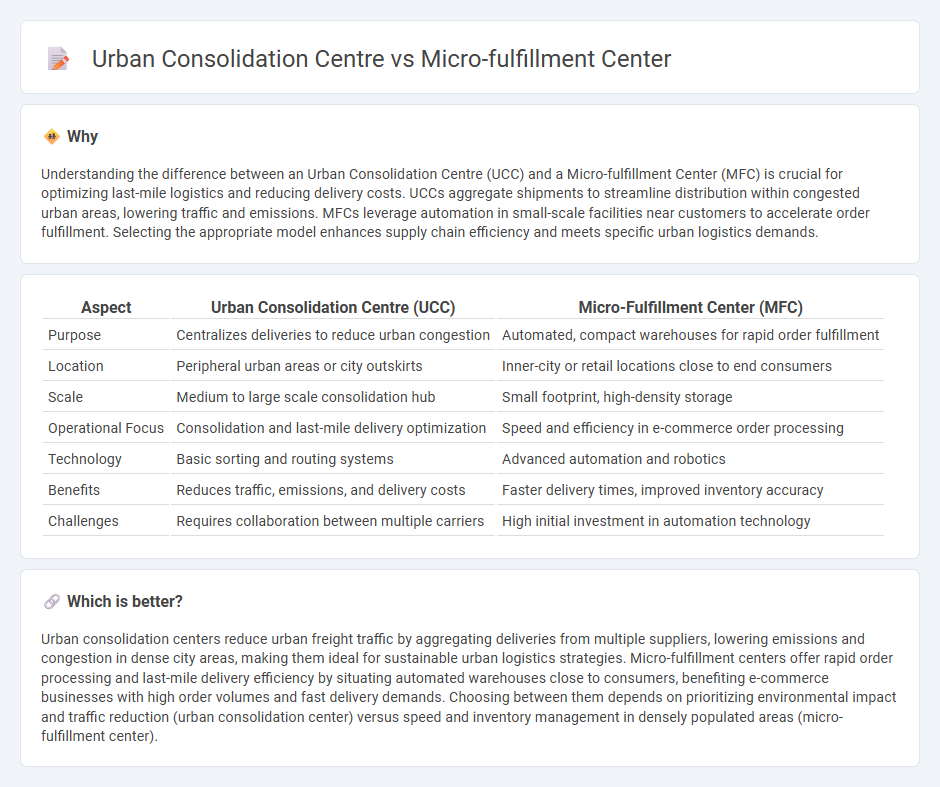
Urban consolidation centers streamline last-mile delivery by aggregating shipments from multiple suppliers to reduce congestion and emissions in city centers. Micro-fulfillment centers enhance e-commerce efficiency by using automated systems for rapid order processing within small urban warehouse spaces. Explore the differences and benefits of these logistics solutions to optimize your supply chain strategy.
Why it is important
Understanding the difference between an Urban Consolidation Centre (UCC) and a Micro-fulfillment Center (MFC) is crucial for optimizing last-mile logistics and reducing delivery costs. UCCs aggregate shipments to streamline distribution within congested urban areas, lowering traffic and emissions. MFCs leverage automation in small-scale facilities near customers to accelerate order fulfillment. Selecting the appropriate model enhances supply chain efficiency and meets specific urban logistics demands.
Comparison Table
| Aspect | Urban Consolidation Centre (UCC) | Micro-Fulfillment Center (MFC) |
|---|---|---|
| Purpose | Centralizes deliveries to reduce urban congestion | Automated, compact warehouses for rapid order fulfillment |
| Location | Peripheral urban areas or city outskirts | Inner-city or retail locations close to end consumers |
| Scale | Medium to large scale consolidation hub | Small footprint, high-density storage |
| Operational Focus | Consolidation and last-mile delivery optimization | Speed and efficiency in e-commerce order processing |
| Technology | Basic sorting and routing systems | Advanced automation and robotics |
| Benefits | Reduces traffic, emissions, and delivery costs | Faster delivery times, improved inventory accuracy |
| Challenges | Requires collaboration between multiple carriers | High initial investment in automation technology |
Which is better?
Urban consolidation centers reduce urban freight traffic by aggregating deliveries from multiple suppliers, lowering emissions and congestion in dense city areas, making them ideal for sustainable urban logistics strategies. Micro-fulfillment centers offer rapid order processing and last-mile delivery efficiency by situating automated warehouses close to consumers, benefiting e-commerce businesses with high order volumes and fast delivery demands. Choosing between them depends on prioritizing environmental impact and traffic reduction (urban consolidation center) versus speed and inventory management in densely populated areas (micro-fulfillment center).
Connection
Urban consolidation centers optimize last-mile delivery by aggregating shipments from multiple suppliers, reducing traffic congestion and emissions in city centers. Micro-fulfillment centers complement this by using automated storage and retrieval systems near or within urban areas to speed up order processing and enhance delivery efficiency. Integrating these facilities streamlines logistics operations, cutting costs and improving service levels in dense metropolitan markets.
Key Terms
Inventory Management
Micro-fulfillment centers enhance inventory management by enabling rapid stock replenishment and localized order fulfillment, reducing lead times and minimizing inventory holding costs. Urban consolidation centers optimize inventory by centralizing goods from multiple suppliers, streamlining last-mile deliveries, and decreasing stock redundancy across urban retail locations. Explore further to understand how these strategies transform inventory efficiency in modern logistics.
Last-Mile Delivery
Micro-fulfillment centers enhance last-mile delivery by enabling rapid order processing close to dense urban populations, reducing delivery times and transportation costs. Urban consolidation centers aggregate shipments from multiple suppliers before final delivery, minimizing urban traffic congestion and optimizing delivery routes. Explore further to understand how these models improve efficiency and sustainability in last-mile logistics.
Order Consolidation
Micro-fulfillment centers streamline last-mile delivery by enabling rapid order picking and packing within urban areas, effectively reducing delivery times and costs. Urban consolidation centers aggregate shipments from multiple suppliers before final delivery, minimizing vehicle trips and lowering urban congestion. Explore the detailed advantages of order consolidation in these innovative logistics solutions to enhance supply chain efficiency.
Source and External Links
What Are Micro Fulfillment Centers? - City National Bank - Micro fulfillment centers (MFCs) are small warehouses typically 3,000 to 10,000 square feet, holding up to 15,000 items for rapid order fulfillment, often using robots or human pickers to handle fast-moving products close to customers, enabling more frequent inventory turnover and faster shipping than traditional large warehouses.
Micro fulfillment center: How it helps retailers speed up fulfillment - An MFC is a small-scale storage and fulfillment facility positioned in urban areas near consumers to accelerate order delivery, often equipped with automation and storing inventory for a short time (24-48 hours' worth), allowing retailers to offer faster pickup and delivery options compared to large, distant warehouses.
Micro-Fulfillment: The Next Step to Faster, More Efficient Last-Mile Delivery - MFCs improve last-mile delivery efficiency by situating compact, highly automated warehouses in population-dense areas, which can reduce order fulfillment costs by up to 75% and allow smaller companies to compete effectively with larger e-commerce players through cost-saving, proximity-based logistics.
 dowidth.com
dowidth.com